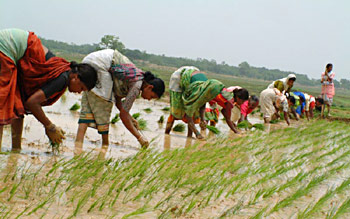 Farming or agriculture has been the principal occupation for the people in Indian village since the ancient period. Farming in Indian villages is the mainstay for a majority of the total population, as they earn their livelihoods from agriculture. The people cultivate various types of crops throughout the year.
Farming or agriculture has been the principal occupation for the people in Indian village since the ancient period. Farming in Indian villages is the mainstay for a majority of the total population, as they earn their livelihoods from agriculture. The people cultivate various types of crops throughout the year. The climatic condition in India is perfectly suitable for agricultural activities and has been one of the major reasons behind people choosing farming as their principal occupation. In ancient India, farming in Indian villages was highly dependent on the monsoon condition and hence, most of the crops cultivated during that period were monsoon type crops. In the contemporary period, the dependency on weather has lessened with the advancement of irrigation technology and different types of crops are being cultivated in India.
People in Indian villages are involved with the agriculture sector in various ways. There are many people in Indian villages who cultivate crops independently in their own lands. They occasionally take help of others to do the farming. Another type of farmers in the Indian villages are those who do not have any land of their own. They help others to cultivate crops in their lands. In this way, these people are dependent on agriculture for earning their livelihoods. There are also many people in Indian villages who are involved in contract farming. In contract farming a person takes care of someone else`s land and cultivates crops in the land. He gets a certain portion of the cultivated crops at the end of the season as his rewards. This is a very common practice in the Indian villages. In this way also, farming in Indian villages is providing occupation to many people.
Another form of farming in Indian villages that provides occupation to the villagers is organic farming. The organic farmers mostly rely on crop rotation, crop residues, animal organics and mechanical cultivation to maintain soil productivity and farmland. The main objective behind this is to supply plant nutrients and to control weeds, insects and other pests. More and more people in Indian villages are getting involved in organic farming, as this helps a lot to retain the productivity and fertility of the land for a long period.
Farming in Indian villages provides employment to more people than any other economic sector. The dependency of Indian villagers on agriculture and the suitable climatic condition has made India the largest producer of milk, cashew nuts, coconut, tea, ginger, turmeric and black pepper in the world. India is also the second highest producer of farm products in the world. As a whole, it can be said that farming in Indian villages is the backbone of the entire economical structure of India.
No comments:
Post a Comment